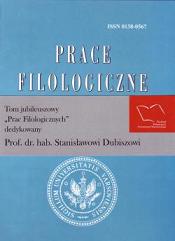Staro- i nowotestamentowe źródła judeochrześcijańskiego pojęcia nadziei − preliminaria
The Old and New Testament Sources of the Juadaeo-Christian Concept of Hope
Author(s): Piotr SobotkaSubject(s): Language and Literature Studies
Published by: Wydział Polonistyki Uniwersytetu Warszawskiego
Keywords: pojęcie ‘nadziei’; znaczenie; Stary i Nowy Testament; języki indo-europejskie; concept of Hope; meaning; Old and New Testament; Indo-European languages
Summary/Abstract: The present paper is an attempt at a new look at sources of the present-day Indo-European names of ‘hope’. In fact there is no common root of these names. Originally the particular expressions meant e.g. ‘to want sth’ →‘to wait for’ (Gr. έλπίζω), ‘to weave sth’ (old Slav. {*nadějati sę}), ‘to jump for’ (Eng. {hope}). These words referred to different concepts. What is the reason for the relative equivalence of these expressions? In my opinion it could be explained by a reference to a common source (Q), which is Hebrew and Greek texts of Bible. There are 15 lexical units in Hebrew with their meaning close to the English word {hope}. They are motivated by such concepts as ‘to take shelter from’, ‘to wait for’, ‘to be stupid’, ‘to be safe/ secure’, ‘to plait’, ‘to examine’. The meanings of Greek forms {elpidzo, elpis} have changed under the influence of Hebrew semantic system. It was due to Christianity and St. Paul’s theology that the new meaning of the word ‘hope’ spread across Indo-European languages. There is every indication that quasi-synonymy relations between {to hope} and {to trust, to hope} and {to have confidence} etc. takes its root in the biblical way of thinking.
Journal: Prace Filologiczne
- Issue Year: 2007
- Issue No: 53
- Page Range: 543-556
- Page Count: 14
- Language: Polish

